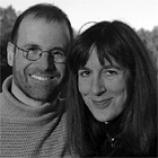Interview: October 7, 2005
Bookreporter.com's Carol Fitzgerald and Jennifer Krieger interviewed Lisa Grunwald and Stephen J. Adler about their latest collaboration, WOMEN'S LETTERS --- a compilation of correspondence by American women during the Revolutionary War, the present day, and every era in between. Grunwald and Adler discuss the surprising revelations about women they experienced through the research and assemblage of this collection, as well as the disparate perspectives these letters provide on major historical events. They also share their thoughts on how the act of writing functions in day-to-day life and what the letters come to represent about society as a whole.
Bookreporter.com: Your previous work was LETTERS OF THE CENTURY, a collection of 423 letters chronicling the 20th century. WOMEN'S LETTERS seems like a natural progression from this work. How and why did you start this project?
Lisa Grunwald & Stephen J. Adler: The presence of so many terrific women's letters in our 20th-century volume is really what inspired this one --- that, and the fact that looking for letters had become such a truly joyful addiction. The prospect of rummaging through 230 years of history, instead of just a single century, was especially enticing.
BRC: The preface of each chapter gives readers a crash-course in the history of that period and sets the stage for the letters that focus on the small and personal impact of these national events. Did you have that format in mind from the beginning, or did it develop as you began culling and organizing these letters? Was it a challenge to write these opening pieces that crystallize each time period for readers?
LG & SJA: The chapter introductions were constructed, bit by bit, throughout the research process. In some cases, just reading about an event or trend in a given decade inspired us to seek letters that would reflect it. In other cases, letters we found would remind us to seek facts that put it in context. And to be honest, the greatest challenge in putting together the introductions was really in keeping them to only three pages each. Fun facts are as much fun to find as they are to read.
BRC: We were pleasantly surprised by how politically versed the women of 1775-1799 were. From Abigail Adams to Sally Wister (a young Quaker lady writing to her sister), they demonstrated a keen understanding of government. What did you find to be the most unexpected aspect of women's lives that some of these pre-20th century letters revealed?
LG & SJA: Other than the political savvy you mention, the humor of these early American women was probably most unexpected. Not that with war, smallpox, infant mortality, and countless other hardships, there was that much to yuk it up about. But when humor did creep in, it was a joyful reminder of the universality of human experience. Playfulness, cattiness, flirtation, teasing --- these appear in even some of the earliest letters in the book.
BRC: The multidisciplinary musings of Edna St. Vincent Millay in her 1924 letter to Eugen Jan Boissevain demonstrated a finely tuned, brilliant mind. Did you find any particular letters or correspondences particularly unexpected or inspirational?
LG & SJA: We were particularly inspired by the letters that showed strength, or perseverance. A woman who described the mastectomy she had to endure without anesthesia. The separations and deprivations of each of the wars. The courage and vision of the suffragists fighting a battle they knew would take more than one generation to win. The sturdiness of the friendships that enabled women to share their burdens and joys. The tenacity of mothers to defend and protect their children.
BRC: Many of these letters highlight both women's frustration with the bureaucracy of the male-run judicial systems and their attempts to subvert it. Were you surprised by the tenacity of women --- like Ruby Bates, who wrote to her boyfriend in 1932 regarding her role in the racially volatile trial of The Scottsboro Boys, and Mrs. Hillyer, who begged the Seattle Bureau of Prohibition to arrest the bootlegger her husband frequented, even giving them the exact times that he would be at home?
LG & SJA: It would be hard to say that women's attempts to work in or around the male-dominated system exactly surprised us, because there's been a lot of wonderful research done on women's contributions to social and political movements in the United States. But it is inspiring to experience their resolve close-up, through their own correspondence, rather than at a greater historical distance.
BRC: Do you agree with Eleanor Roosevelt's assertion that "everyone thinks their situation is unique" and that, by writing letters, women were somehow trying to establish their importance, their place in history?
LG & SJA: For the most part, the letters in this volume don't seem to be written with history in mind --- which is frankly one of the reasons we found them so appealing. Occasionally there will be a letter --- accounts of battles, for example --- in which you get the sense that the author is writing for posterity. But usually they are just part of everyday life. Only later do they emerge as "historical."
BRC: Simply because of their close proximity, many of the women's letters shed new light on relatively minor elements of major historical events. From the release of GONE WITH THE WIND to the bombing of Pearl Harbor, readers see these world-changing occurrences from a different angle. Was there one specific historical incident or era that you felt was particularly illuminated by the letters you chose?
LG & SJA: That would have to be Lincoln's assassination, an event that truly changed for us when we read the eyewitness accounts of women who were at Ford's Theater that night. We actually ended up using two letters about it --- contradicting our usual rule of one letter per author or event. But we simply couldn't choose between the two and so you'll find both in the book.
BRC: With a few notable exceptions, the majority of the letters from 1980-2005 are, by their very nature, a grim portrait of our nation as a whole; they seem to speak of a kind of downfall, both of the sanctity of the written word and of the basic moral structures of our founding ideals and ourselves. Do you agree, and were you aware, going into this last chapter, of how different the tone of these letters would be from those of the previous generations?
LG & SJA: It's hard to know whether a similar question might have been asked at the end of the 19th century. It's possible that the conflicts and perils of contemporary life always seem somewhat apocalyptic to the generation experiencing them. Also, the last chapter is not all doom and gloom --- there is evidence of courage, of love, of faith, of patriotism, of family, throughout. But we both tend to be optimists when it comes to America's chances for renewal. One thing this volume suggests is that we've been in bad places before, and have emerged even stronger.
BRC: The care and attention to finite details in language, the masterful construction of sentences that so many of these letters possess is particularly poignant as, in the wake of technical advances such as e-mail, instant messaging and cell phone accessibility, the letter itself seems to be a lost art. Do you mourn the loss of letter writing in our society? What do you think e-mail has done for communication, both good and bad?
LG & SJA: We're not among those who decry e-mail for its effect on letter-writing. Our feeling is that if you really want to point a finger at any technological advance, it should be at the telephone. E-mail, while definitely lending itself to plenty of non-poetic communication, also is at least a revival of written rather than spoken thought. Also, bear in mind that we didn't includes notes in this volume from the 19th century that said, "Dear, please remember to purchase some flax," or whatever. There were plenty of those.
BRC: We saw a recent review (Minneapolis Star Tribune) that said this work provided "a much more intimate connection to the past --- and a better understanding of it ---than most college textbooks can." When putting this collection together, were you thinking about its academic applications?
LG & SJA: As with the first volume, we were certainly hoping that this book would be considered as a resource of social history. Not being historians ourselves, we definitely received an excellent education in our search for and selection of these letters.
BRC: When you were in school, did you enjoy studying history? If so, did you enjoy learning history through historical facts, or from stories based on people from a particular period?
LG & SJA: Neither of us majored in history, although we both took a number of history courses. We both remember great teachers who brought the past to life in their lectures. Stephen has always enjoyed historical novels and we both devour biographies and, of course, letters collections. It's always been tough for either of us to draw much excitement from cold historical facts.
BRC: Are you both letter writers? Do you think differently about your written correspondence after editing these two books?
LG & SJA: We have both been letter writers at different points in our lives; in fact, our relationship started eighteen years ago with Stephen writing one particularly nifty postcard to Lisa. These days it's much more likely to e-mail with friends who live far away, and we'd like to think we take care with the way they're written. We subscribe to the handwritten thank you note whenever possible. And of course, answer letters from readers.
BRC: Do you see yourselves collaborating on another collection of letters in the future? If so, what might its theme be?
LG & SJA: Working on these two books has given us, separately and together, some of our most gratifying professional moments, so while we don't have a theme selected for a next volume, we're hopeful that we'll find just the right one.





